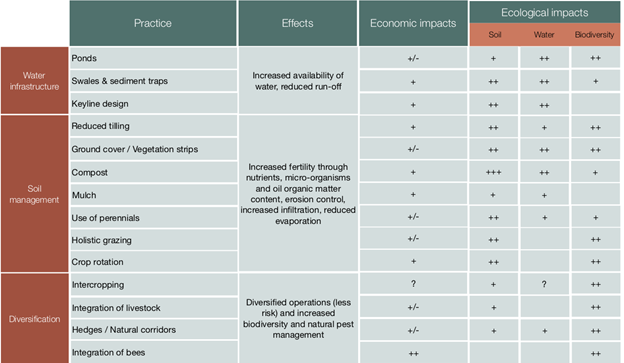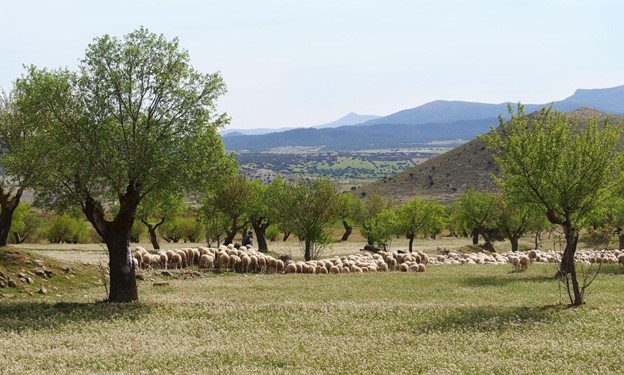Regenerative Agriculture: What is it? Who is it for? Common practices, principles and resources
Livestock, green manures, and almond integration in the Alvelal region, Spain. By: Alvelal Association
Regenerative agriculture is hot, but what is it? Discover through this article the basics of regenerative agriculture and why this could be a solution for you.
What is regenerative agriculture?
“Regenerative organic agriculture improves the resources it uses, rather than destroying or depleting them. It is a holistic systems approach to agriculture that encourages continual on-farm innovation for the environmental, social, economic and spiritual well-being.”
— Rodale Institute —
Regenerative Agriculture aims to restore and enhance farming ecosystems’ resources and resilience, bringing environmental benefits and economic stability to farmers and their associated communities. Regenerative agriculture takes a holistic view of the land, taking into account the local context, the farmer’s goals and the connections between different resources such as water, soil, biodiversity, crops, livestock and the business model. It actually uses techniques and practices to improve these resources. Two examples of such practices are the use of cover crops and keyline planting, which have a positive impact on soil quality and health, while at the same time increasing biodiversity (above ground and below ground) and capturing and retaining water. Regenerative agriculture supports and enhances ecological processes and ecosystem services such as nutrient cycling, carbon sequestration, nitrogen fixation, natural pest control and improving the water cycle. By replenishing and enhancing the correct functioning of ecosystems, regenerative practices enable farmers to have stable and nutritious food production. It can also help you become a steward of your land, revitalizing it and securing a healthy, abundant farm for generations to come.
Differences between traditional, conventional and organic farming:

Table extracted from EIT-Food Regenerative Agriculture Manual “introduction”.
Why do we need regenerative agriculture?
“Farming has become incredibly costly to the environment – and to the farmer. It is time to change this “
– EIT-Food Regenerative Agriculture Manual “Introduction”–
As a farmer, you know it’s not always easy and profitable to produce food as you increasingly face the challenges of a changing and unpredictable climate, increased disease and pest outbreaks and the negative effects of chemicals and tiling on soil fertility and structure (soil degradation). In the long run, conventional farming methods reduce the productivity of the land and make farmers dependent on external inputs such as fertilizers. Conventionally managed soil becomes decarbonized impacting soils’ capability to retain and infiltrate water, meaning more irrigation is needed. According to Maria-Helena Semedo of the FAO (global symposium on soil erosion, 2019) if current rates of soil loss continue (by processes such as erosion, desertification, salinization, chemical pollution and decarbonization), within 60 years we will not have enough functional topsoil to feed ourselves, posing serious challenges to public health. There is, therefore, a need to change from current conventional agriculture towards a farming system that can “keep carbon in the ground, support biodiversity, rebuild soil fertility and sustain yields over time, providing a basis for secure farms” (IPES rapport, Frison 2016, p. 3). Healthy, living organic topsoils store carbon, retain water, and preserve and cycle nutrients. Regenerative agriculture, therefore, proposes a system that sequesters carbon from the atmosphere and has the potential to reverse climate change instead of contributing to it. “Regenerative Agriculture gives us the chance to improve food quality, protect farmers’ livelihoods, and safeguard the land we depend on” (EIT-Food website).
Who is regenerative agriculture for?
“For some people, it will mean taking a no-till approach; for others, it will mean planting cover crops or spreading compost. For a few, it means a holistic approach where every plant, animal and human plays a crucial role. Every farmer can choose an approach that suits their land”
– Matteo Mazzola, EIT-Food Regenerative Agriculture Manuals “Case studies” –
Regenerative agriculture is for any farmer who wants to positively impact their land. From smallholders, and hobby farmers to big agribusiness. It allows you to restore and improve soil quality and properties, improve biodiversity, and water capture and retention. Everyone can start to be a regenerative farmer, you can start with small steps. There is no need to implement all practices at once. Regenerative agriculture in practice is a journey, a new way of looking at farming, an intention to continuously and actively work on improving farm resources. You help the ecosystem work with you. It starts by looking at your farm as a whole, holistically, and setting the goals you want to achieve. From there, you can decide which regenerative practices will best suit your context, farm and goals. Many farmers start applying practices focused on soil improvement, by bringing back soil life and organic matter. Then they move on to restore other important ecological functions, like sustaining insect populations that ensure natural pest control. As you know, your farm is a dynamic environment, this continuous improvement aims at utilizing and working with the full potential of your farm ecosystem.
What are some common regenerative agricultural practices and their effects?
The choice and use of regenerative agriculture practices vary by region, context, goals, and history of the farm; there isn’t a “one size fits all” solution. Remember that practices work differently in different farm ecosystems and therefore need to be adapted to the specific context. Choose the practices that best suit your farm. Here is a list of common practices in semi-arid regions and their associated benefits:


Example practices of regenerative agriculture on La Junquera farm (Spain); A. Making a swale (contour trench); B. Almonds on key-line design; C. Pond; D. Hedge of aromatics; E. Use of straw as mulch in the vegetable garden.
What are the principles of regenerative agriculture?
There are 5 main regenerative agriculture principles and one additional optional principle. When used in combination they can offer incredible results.

Modificated from EIT-Food Regenerative Manuals
1. Understanding your context
There is no ‘one size fits all’. Consider your own specific conditions of land, soil, climate, crops, location, access to machinery, financial resources, cooperatives, tradition, market opportunities, etc. Next to the objectives you want to achieve. This will influence the decisions you take.
2. Improving soil quality and health
The soil is the most important asset of the farm. Taking care of and improving it will secure the base from which all other parts of the farm will flourish. To protect our soils, minimizing disturbance, ensuring a sufficient soil cover and feeding a living soil appropriately are some of the basic principles. Examples of such practices are: no-till, planting cover crops, using crop rotations, integrating livestock, etc.
3. Improving water management
Water is becoming more and more scarce. Using and harvesting this resource efficiently is key to success. Next to this, water bodies on farms promote biodiversity hotspots. The use of key-line design, ponds, and swales can help retain and infiltrate rainwater on your farm.
4. Biodiversity
Biodiversity is key to creating balance in your farm, from an ecological to an economic point of view. Enhancing biodiversity below and above ground will promote the correct cycling of nutrients and create natural pest control. Diversity in crop production is a good strategy to spread risks and bring economic stability to the farm. Practices are: the creation of hedges, crop rotations, the inclusion of perennials, livestock integration, restoring natural zones, etc.
5. Holistic decision making
Take the entire ecological system into account and balance economic, social and environmental considerations when planning and making decisions.
Sometimes a sixth principle is added:
6. Create community and social impact
Take into account the local and international societies around you. How can you create a positive impact with them? Is it by growing healthy food, sharing knowledge, enhancing local economies and/ or creative spaces? Connecting with others can create meaningful connections, moments of inspiration and greater impact by enhancing resilient communities.
“For me, regenerative means rebirth. The rebirth of the soil, of agriculture itself, and of the farming community. This social aspect goes hand in hand with building a network of productive businesses that also respect the surrounding ecosystem.”
–Emilia Blasi- EIT-Food Regenerative manuals “Case studies”–
Cover picture by: Alvelal Association
This article was written by Clara Bosch and reviewed by Yanniek Schoonhoven and Alana Bell, working at the Regeneration Academy. Pictures were shared and edited by A Regenerar.
Resources:
EIT-Food Website pages about regenerative agriculture:
1. https://www.eitfood.eu/projects/regenag-revolution/what-is-regenerative-agriculture
2. https://www.eitfood.eu/projects/regenag-revolution
EIT-Food Regenerative agricultural manuals: https://www.eitfood.eu/projects/regenag-revolution/the-regenerative-agriculture-manual
Rodale Institute: https://rodaleinstitute.org/why-organic/organic-basics/regenerative-organic-agriculture/
Kiss the Ground webpage explaining regenerative agriculture:
https://kisstheground.com/regenerative-agriculture/
Regeneration International: https://regenerationinternational.org/why-regenerative-agriculture/
FAO website page about soil erosion: https://www.fao.org/newsroom/detail/Save-Our-Soils-Finding-ways-to-stop-erosion/en
IPES rapport, Frison 2016: https://www.ipes-food.org/_img/upload/files/UniformityToDiversity_FULL.pdf
Alvelal website: https://www.alvelal.net
La Junquera website (regenerative farm): https://www.lajunquera.com/
Regeneration Academy website: https://www.regeneration-academy.org/
Farm practices to increase biodiversity and enhance ecosystem services
Regenerative Agriculture: What is it? Who is it for? Common practices, principles and resources









































































